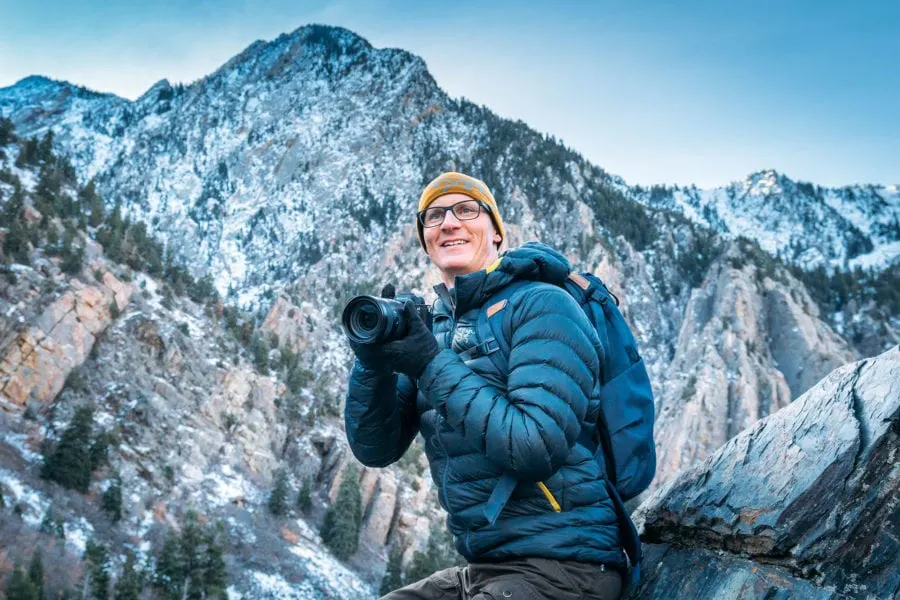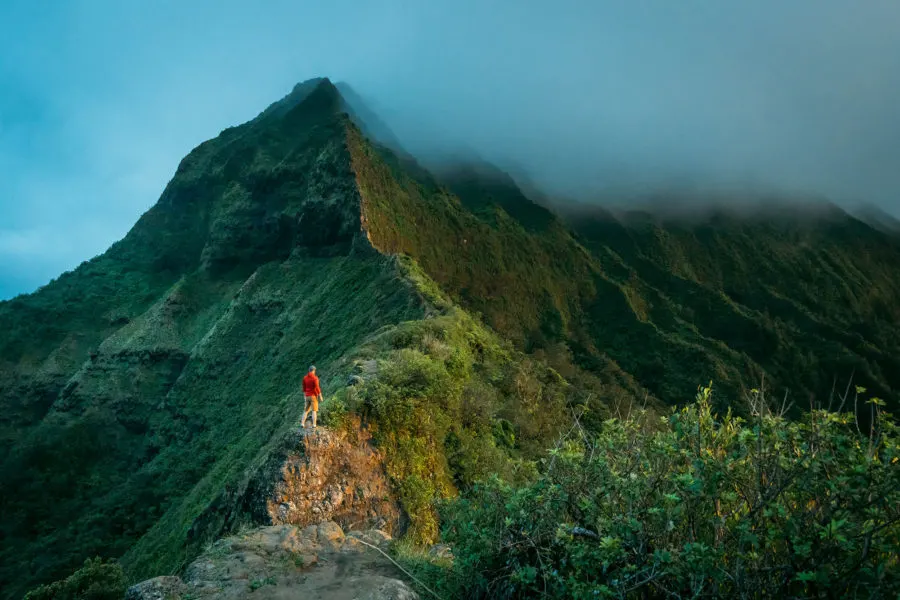
Photography tips
Turning freelance photography into a paid profession is a dream for many people. While difficult, it’s definitely possible. Here’s how to make money as a successful photographer.
I’ve been working as a professional freelance photographer for the past 10-years or so. Getting paid to travel the world shooting photos of exotic destinations and licensing my images to different organizations is a pretty awesome job.
I’ve even sold some images to National Geographic!
Freelance photography is a profession that’s constantly changing, and to make it work you need to stay on top of all the latest trends — like post-processing techniques, social media skills, networking, and successful business models.
In this guide I’m going to share helpful tips for how to become a freelance photographer and actually make money from your photography.
These are suggestions based on what I’ve learned over the years, along with a few wisdom nuggets from some of my favorite travel & adventure photographers.

Hi, I’m Matthew Karsten
I’ve been traveling the world for 10+ years as a professional photographer & writer. I hope you enjoy my photography business tips! If you find them useful, please consider sharing. Thanks!
- What Is Freelance Photography?
- The Reality Of Photography As A Profession
- 9 Steps To Professional Photography Success
- 1: Improve Your Photography Skills
- 2. Develop A Focus & Style
- 3. Create A Website
- 4. Build A Portfolio & Media Kit
- 5. Promote Your Photos On Social Media
- 6. Pitching & Networking To Find Jobs
- 7. Making Money As A Freelance Photographer
- 8. Figuring Out How Much To Charge
- 9: Defining Photography Success
- Helpful Tools & Resources For Freelance Photographers
What Is Freelance Photography?
Freelance photography is providing photos to clients and licensing them for a fee, or working as a self-employed freelance photographer. You can get hired in advance for specific projects, or shoot the photos first — selling them later.
There are many different types of professional photography jobs out there, like travel photography, landscape photography, commercial photography, portraits, wedding photography, or fine-art photography.
In this guide I’m going to focus on a mix of travel, adventure, commercial, and editorial photography. The quintessential dream photography jobs. However the advice can be relevant for other kinds of photography too.
The Reality Of Photography As A Profession

The life of a professional freelance photographer can be hard. Especially in the beginning of your career. Personally, it took me a few years to earn any money at all. And that’s pretty common.
You’ll often work alone, for long hours, with very little stability (or income). It is a long-term commitment, with no guarantee of success, and many people eventually give up.
Pursuing a freelance photography career is definitely not for everyone…
That said, if you DO find a way to make it work, it’s one of the coolest jobs out there. And the longer you do it, the more you learn, and the more money you can make.
Even after many years working my butt off, for little pay, and occasionally questioning my life choices along the way, I wouldn’t trade working as a freelance travel photographer for anything else!
9 Steps To Professional Photography Success
1: Improve Your Photography Skills


Never stop learning! I get many emails from people asking for tips on how to make money from photography, and after viewing their work, usually my top piece of advice is — to get better at photography.
Which may sound kind of harsh, but often true.
Hey, I’ll be the first to tell you I’m not the best photographer out there. I’m constantly learning new things from others, investing both time & money into training to make that happen.
Owning a nice camera does not make you a great photographer. Practice, experience, and skill do. There is ALWAYS room to get better at composition, lighting, post-processing techniques, creativity, location scouting, and more.
For example, shooting photos is easy, but meticulously planning to be at the right place, at the right time, is far more difficult and requires more patience.
Maybe you know your camera like the back of your hand, but how are your Lightroom & Photoshop skills? Do you understand how to focus stack or create luminosity masks?
So before you start pitching brands for projects, ensure your photography will truly stand out from all the other freelance photographers doing the same. You don’t have to be the best, but you do need to hold your own among other pros.

Online Photography Courses
Want to improve your photography? Fancy gear is nice, but learning from other photographers is a better investment.
2. Develop A Focus & Style


If you’re shooting the same kinds of photos as everyone else, your work won’t stand out and you’ll get lost in the sea of people just trying to copy the most popular photos on Instagram.
While it won’t happen overnight, you need to develop a personal style of photography. Something people will remember you for. Focus on a specialty, like ariel drone photography, or outdoor sports photography, or even fantasy portraits.
While you can certainly practice other kinds of photography, you should try to keep your portfolio narrow and focused, to make it easy to “define” your style. So when someone is looking for an underwater photographer, they can see right away that’s your specialty.
Editing and processing your photos in a certain style can help with this too.
Some clients are looking for realistic images, others want a more dreamy and ephemeral vibe. Just because you CAN do it all, doesn’t mean you should.
The photographers who get regular work often do so because they become known for a particular style.
3. Create A Website


I’m sure you already have accounts with Instagram, Facebook, maybe 500px too — but do you have an actual photography website & blog yet?
A professional website is what many potential clients will want to see.
Put together a strong portfolio of your best shots (more on that later) and make sure it’s easy to navigate. Buy an actual domain name — using your name or company name if possible.
Include a blog section on the website, where you can post updates about your latest photography projects, photo tips, philosophy on life, whatever. The blog will help people get to know you, and can even attract new clients.
If you want to start a blog, I’d recommend a self-hosted WordPress site. If you want to create a beautiful online photography portfolio of your work, and sell your own prints, I’d also get an account with SmugMug.
This is my personal setup, and it’s worked very well for many years! In fact, I’ve sold many images to companies who’ve discovered my work either on my blog, or on my SmugMug account after a simple Google search for a specific type of image.
Get your work out there online, learn about keywords and SEO, make sure it’s easy for others to find your images — and they eventually will.
4. Build A Portfolio & Media Kit


Freelance Photographer Portfolio
One of the most important things you can do as a photographer is invest in personal projects to help build a portfolio of work that will get you noticed by clients. A portfolio is simply a collection of your best photos.
Want to become a travel photographer? Well you’ll probably need to spend your own money on travel to get some amazing shots for your portfolio, which you can then use to pitch travel destinations or travel brands.
Want to work with backpack, tent, and other outdoor gear brands? You’ll need to get out into the mountains and shoot some product photography examples for your portfolio which will match what these kinds of brands are looking for.
There are no shortcuts here. You need to spend money & time building a strong portfolio of work that will “sell” your services to potential clients later.
Your portfolio can be based online, but I highly recommend you also create a PDF version which is easily emailed or printed out and passed around an office.
Creating A Media Kit
You can think of a media kit as the story of you and your work, in PDF form. It contains elements of a portfolio, but with more information that will help clients decide whether to hire you or not.
It’s kind of like a pitch deck (which I’ll describe a bit later), but rather than pitching a specific project, you’re simply pitching yourself.
Generally a media kit starts with an introduction about you, sharing your personal mission statement, a healthy selection of images from your portfolio, and maybe some examples of past clients if applicable — plus contact details of course.
If you have a strong social media presence, many media kits will mention things like follower numbers across different social media platforms too.
Want an example? You can download my media kit here.
5. Promote Your Photos On Social Media


Share your work regularly on social media. Daily if possible. Create & share. Create & share. Rinse & repeat.
Share your work consistently, both for the encouragement & praise you receive from others, as well as to flood the market with your art.
You never know what photo or video will resonate with people, or what will viral on social media. Or when some brand will happen to be searching for a new freelance photographer to hire.
To maximize your chances of discovery, you need to constantly create — and share. Over and over again. They don’t call us “creators” for nothing!
Social Media Growth Tips & Tricks
- Do Interesting Things – The people growing fastest on social media are always creating interesting, unique, and fun content. They aren’t sitting at home worrying about followers, they’re actively creating. Does that mean selling all your stuff and living in a van? Maybe. But it doesn’t have to. Just get out there and do cool stuff on a regular basis!
- Engage With Others – Actually respond to the comments left on your photos. Leave meaningful comments on other people’s content too. Maybe send a direct message asking a follow-up question. This can be time-consuming, but valuable. Set aside an hour or two each day specifically to engage with others.
- Get Featured – The days of easy Instagram & Facebook follower growth have slowed down, but you can still attract new followers when big accounts feature your work. See what hashtags are trending. Reach out to accounts that share other people’s work via direct message to show them you have something that fits their current theme. Do it on a regular basis.
- Provide Tons Of Value – Help other people with their own photography — and your social media accounts will grow much faster. You have to give people a reason to follow your account, more than just pretty pictures. If they get some free lessons from time to time, they are far more likely to stick around.
6. Pitching & Networking To Find Jobs


The truth about becoming a freelance photographer is that you need to put yourself out there to find jobs. Shooting photos is often the easy part!
Networking is the very important business skill that will determine if you make money from your photography or not. Make a list of the people, brands, and agencies that you’d like to work with, and reach out.
Try starting with smaller brands first.
Study the brand and its values. Interact with their online content for a while in a meaningful way. Then, cold call them on the phone, send an email, or reach out with a direct message on social media (Instagram, Twitter, LinkedIn).
Tell them you like what they do. Don’t be creepy, annoying, or pushy. Then find out if there’s a way you can work together on a future project. Attach that media kit & portfolio you just put together!
Other than individual brands, you may want to try to reach out to “agencies” too. An agency is in charge of managing the marketing for many different brands, often in a particular category. There is potential for much more work if you can build a relationship with an agency.
You may hear a lot of “we’re not looking for anyone right now” at first. Never take it personally, and just remember this is a numbers game.
Some of the most successful freelance photographers are the ones who work the hardest at pitching & networking — day in, and day out.
Preparing A Pitch Deck
A pitch deck is different from your media kit or portfolio mentioned earlier. The purpose of a pitch deck is to “pitch” a specific project idea to a brand.
Some companies will come to you with projects, while others might want you to pitch them a new idea. Learning how to prepare a professional and convincing pitch deck for either of these situations is an art-form in itself.
A convincing pitch deck PDF usually contains the following:
- A project overview that states project objectives, and how you plan to meet those objectives.
- Reference images to support your idea — preferably from your own past work or portfolio. Again, this is why building a strong portfolio is important.
- A bid on the project (how much you’ll charge), which you might send with the pitch deck as a separate document.
- A timeline listing prep days and shooting days, plus any key dates for the agency/client to approve things to stay on schedule.
7. Making Money As A Freelance Photographer

One thing I’ve learned after working for the last 10-years as a freelance travel photographer is that to earn decent money in this business, you really need to diversify your photography income sources.
This will both increase your earning potential, as well as hedge against changes in the market (worldwide pandemics, anyone?). So if one source of income suddenly disappears, you aren’t completely screwed!
Here are the most popular ways to make money from photography.
Editorial Photography
Editorial photography basically means your images are being used in newspapers and magazines to accompany articles about a certain subject. For example, a photo of a camel in the desert published in a travel magazine feature about Morocco.
To sell editorial photos, you generally need to work with a magazine editor who can tell you what kinds of images they are looking for in an upcoming issue of the magazine. This requires networking and sending your portfolio to many different magazines on a regular basis.
Commercial Photography
Commercial photography is when your images are being used by brands for marketing and advertising purposes. It pays much more than editorial photography, but usually requires that you have already built up a name for yourself as a photographer, often through editorial work.
Some examples might include shooting photos for a clothing brand, a car company, or even the tourism board for a country.
Rates for commercial photography are negotiable, and can be based on how many images they license from you, for what use, and for how long. Alternatively, many commercial photography projects might pay a day-rate for your time that also gives them a blanket license to any images you create during the project.
Stock Photography
Licensing images you’ve already shot through stock photography sites or rights management companies is one way freelance photographers can earn money.
Many smaller brands don’t have huge budgets to hire photographers for dedicated projects, so they buy temporary photo licenses for work that’s already been created.
Photographers upload their photos to these sites, tag and organize them, then random companies search for images to license.
If you’re able to build up a large portfolio of the kinds of images that are sought after, you can make “passive” income month after month selling your old images.
There are two main types of stock photography companies out there. Rights Managed Stock Agencies and Microstock Sites.
Rights Managed Stock Agencies pay photographers better, because the quality of the work is generally higher, the clients are pickier, and licenses are stricter/more exclusive.
Microstock Websites might only pay you $0.50 for a Royalty Free photo, but hundreds of different websites could be buying and using that same image.
Rights Managed Stock Examples
Microstock Website Examples
Post Licensing & Rights Management Lawyers
A relatively new phenomenon is the launch of post licensing companies that proactively search for your images already being used illegally online, and contacting the copyright infringers on your behalf to demand a licensing fee.
For many photographers, chasing after people who are stealing their images online just isn’t worth the effort. However these new companies, armed with teams of actual lawyers and image tracking software, are MUCH more effective.
They take a large cut of course, but they also do most of the work for you. Here are some examples:
Photography Prints & Coffee Table Books
Selling photo prints, coffee table books, calendars, and other “merch” that feature your photography can be a solid way to earn income for many freelance photographers.
Prints can be especially lucrative if you have a strong online following, and it’s also a great way to help raise money for charities and local organizations that you like.
For example, with the ability to set my own prices on SmugMug, I can ensure I have enough profit to also give 10% of any print sales to the National Parks Foundation. Or launch regular free print giveaways to my social media followers, just for fun.
Selling Lightroom Presets
Lightroom Presets are post-processing settings that many photographers use to obtain a certain “look” with their photos. For people who are new to editing photos using software, using presets can help them easily improve their photos with cool colors, tones, and other adjustments. Many photographers develop and sell their own presets to their followers, which can be a decent source of income.
Creating Online Tutorials
There is far more to good photography and editing than most people think, that’s why getting into the education space and teaching other would-be photographers how to improve their images can be a good way to earn extra income.
Online photography classes allow a photographer to share their knowledge with many more people than trying to do it in person.
Some people charge fees for their tutorials, others provide the training for free on platforms like YouTube and then earn money through the advertising.
Leading Photography Workshops
Leading in-person photography workshops can be an excellent source of income if you have a decent following online. Getting paid to hang out with other people while teaching them your photography techniques in exotic locations around the world can be a lot of fun too!
To launch a successful photography workshop, it helps to have already built up a following of people who love your work, and who are ready to spend money learning from you in person.
Affiliate Marketing
What’s the most common question that every photographer gets? What kind of camera do you use!
Why not recommend your favorite gear to others, and get paid for it?
I make a decent portion of my income from affiliate marketing. Photography gear guides, tripod comparisons, camera bag reviews, even photography tutorials. I’m not promoting stuff I don’t use or believe in, only products that I actually love.
You can share these affiliate links on YouTube, Instagram, or your own photography blog which will generate a small commission off each sale.
The more useful your content is, the more it gets shared, and the more people will click on your links. When more people click your links, the more you earn. Everyone wins!
Lots of companies offer affiliate marketing partnerships. Some good photography related ones include:
8. Figuring Out How Much To Charge


How much should you charge for your photography? Well, there are many factors at play here. Editorial photography? Commercial photography? Print sales? Image use? Licensing time-period? What is your time worth to you? What size problem are you solving for the client?
In general, there is a basic path that many photographers end up following:
- Working for “exposure” (or in exchange for gear/accommodation/activities)
- Editorial photography (standard rates set by the industry)
- Commercial photography (pays much more, with room to negotiate)
- Selling prints (to individuals or companies)
I hesitate mentioning working for exposure, because many professional photographers might disagree, but the reality is many of us started by giving images away for little or no money to build up a portfolio of work to show off.
I’ll give you an example. I once let GoPro use an image I shot of a shark underwater on their social media channels during Shark Week in exchange for just a photo credit/link. The buzz around that photo ended up sending me a few thousand new followers on social media, at a time when I didn’t have many.
These days, my strong social media presence helps me attract new photography clients for paying gigs, so I really don’t regret giving some companies free photos all those years ago, when I was hungry to build a name for myself. This is a personal choice and not every photographer will agree with this route.
The Art Of Negotiation
Don’t be afraid to say no. Sick of giving images away for “exposure”? Just say no and move on. There will be other companies who are willing to pay for your images. Along those same lines, if you send over a quote for a job, and they client says yes right away, you probably should have asked for more!
If you do send a quote, and the client comes back with a lower amount they won’t budge on, the other tool you have at your disposal is to lower the deliverables they’ll receive. If they’re taking money away, you get to take something away too.
EXAMPLES:
- “Sure, I’ll license this photo to you for $500 instead of $1000, but the license will only be good for 1 year instead of 2 years.”
- “Yes — I’ll work on this project for $1500 per day instead of $3000 per day, but you won’t get an exclusive license to the images created — I can re-sell the images elsewhere to supplement my income.”
Note that those examples only really work for commercial photography, as editorial photography often has set rates, and there isn’t a ton of negotiation that goes on.
The art of negotiation in freelance photography is a huge topic, one I can’t cover completely here, but if you’d like to learn more I recommend reading the book: Getting To Yes: Negotiating Agreement Without Giving In
9: Defining Photography Success


Many people love the idea of making a living with their photography. But eventually you realize just how many other freelance photographers are out there with those same dreams of success.
It’s a crowded field!
Just know that there are many levels of success in freelance photography. For some, getting their first paid gig is a huge success. For others, only the cover of a famous magazine will do.
You have to ask yourself — is photography just going to be a hobby? Or are you ready to treat it like a professional career (with all the work that entails)?
When was the last time you contemplated the ROI (return on investment) of a new gear purchase? Do you have a marketing/PR budget set aside for your photography business?
It’s easy to compare yourself to other “successful” photographers, while not truly understanding the blood, sweat, and tears they’ve put into this industry to get to where they are today.
Years of experience. Hundreds of hours of networking. Thousands (or tens-of-thousands) of dollars spent building a portfolio. The logistics & work involved setting up a functioning business.
It’s not impossible to make a living as a freelance photographer these days, but you also need to manage your expectations for what success looks like… and how long it might take to achieve.
Helpful Tools & Resources For Freelance Photographers
- Wonderful Machine – A professional art production agency that also offers consulting services & representation for up-and-coming photographers who are serious about becoming pros.
- Great Online Photography Courses – A rundown of my personal favorite online tutorials and courses for photographers who want to get better.
- FotoQuote – Industry standard photography pricing guide and quote software for freelance photographers, helping you determine a fair price.
- Getty Images Price Calculator – Free online tool for pricing your photography licenses in different mediums & situations.
Enjoy This Article? Pin It!


READ MORE PHOTOGRAPHY TIPS
I hope you enjoyed my guide on becoming a freelance photographer! Hopefully you found it useful. Here are a few more photography related articles that I recommend you read next:
- 20 Tips To Improve Your Photography
- How To Choose A Travel Camera
- What’s In My Camera Bag?
- Peak Design Travel Tripod Review
- Cool Jobs That Let You Travel
- Gifts For Photographers: Unique Photography Gadgets
Have any questions about becoming a professional photographer? Anything I missed? Join the conversation on Facebook, Instagram, or Twitter to share!
